by J. David Truby
© J. David Truby, 2016
With the gun control debate raging the gun banners of President Barack Obama think they have compelling evidence to castrate our Second Amendment rights.
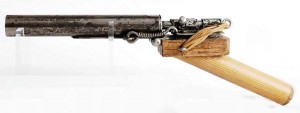
(NBC) This non-firing prop zip gun from the 2005 NBC-TV show “My Name is Earl” was built exactly like the real one, which was confiscated at California’s Pelican Bay State Prison in 2004.
Despite the “Duh Logic” of soaring crime in our nation’s myriad “Gun Free Zones” where laws prohibit lawful citizens from carrying or even owning firearms, there is still only one venue where weapons of any kind are strictly prohibited: Jails and Prisons.
Yet, our American prison system has always had a steady penchant for churning out inventive, handmade weapons; a perfect controlled environment example as to why gun bans do not work. Ever!
Sheena Donovan, a prison systems consultant, added, “Visitor and gate security is vital, but, so is constant in-house surveillance and inspection. A lot of inmates are operationally clever at construction of improvised firearms and this seems to be increasing according to national statistics.”
As I defined in my three books, Improvised Modified Firearms, Vol. I and Vol. II and Zips, Pipes and Pens, the history of guns in penal institutions worldwide is a long one. In the Indian provinces of Bihar and Purvanchal, family workshops still churn out homemade firearms. Almost a century ago, New York City street gangs couldn’t get guns. Their solution was to make weapons of their own design, i.e. zip guns. These could be made by anyone from almost anything, such as air pressure guns, pipes, springs, toy guns, or a camera tripod leg. In the 1950s, you could buy plans to make a cigarette lighter gun for $1. During Vietnam, simple guns were made by villagers, and US soldiers were awestruck at the innovative work these primitive gun shops turned out. It seems when guns are in short supply, necessity is the mother of their invention.
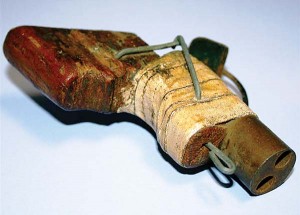
(Kiel Images) A rough, but workable, double-barrel .38 pistol was confiscated by prison security in Michigan in 2010.
“It’s important to remember basically that guns are simplistic weapons, fundamentally unchanged since the 17th century,” as the late Jack Krcma, an iconic ordnance expert, often said.
Within prison walls, guns can be acquired in two ways: they can be smuggled in, or they can be ingeniously created by inmates.
“We’ve seen applications to disguise firearms as basic cameras, camcorders, cell phones or MP3 players. Some of them aren’t quite as sophisticated and just designed to elude security but are really easy to detect visually,” one field agent for the Department of Homeland Security told me. Smuggled contraband is difficult to come by and getting caught is very dangerous these days both for the perpetrator and inmate; therefore, it is less risky to build guns out of pilfered items throughout the prison.
Mike Sharp, a former law enforcement officer said, “Homemade guns in prison is a serious problem. It’s crazy to think what cunning inmates can create out of everyday items.”
Building those guns is not difficult.
In 2015, a Georgia prison guard, testifying at an inmate assault trial, told the judge, “Sometimes, sir, I think there are more guns gotten easier on the inside than out here in our other world.”
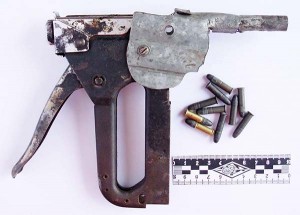
(Folsom State Prison) An industrial staple gun formed the base of this .22 caliber zip gun built at California’s Folsom prison more than a decade ago.
A Pennsylvania Corrections Officer told me, “We try to limit the amount of material they [inmates] have access to that can be used for weapons. Cells and common areas are searched constantly for anything that could be used for a weapon.”
All it takes is some resourcefulness on the inmate’s part.
Behind prison walls, guns and other types of weapons are made of a mishmash of parts, usually in the workshop. It’s ironic that the same machines provided for inmates to learn useful, job-oriented trades are the very same instruments that they use to construct simple, yet effective weapons.
Materials used for fashioning weapons are endless. Guns can be created by using popsicle sticks, electrical tape, batteries, pipes, wood and springs, while other destructive weapons are fashioned out of sharpened plastic, stolen dining equipment and even heavy-duty garden hoses. In 1999, a handgun with a barrel made of paint-hardened toilet paper rolls and a homemade mechanism of steel and aluminum springs was recovered in Folsom Prison.
Today, 3D printers are the newest thing in homemade weapons. They’re dangerous, because weapons are made of non-metallic materials and are undetectable in x-ray machines.
Describing inmates’ scrounging sensibility, one guard from Florida said, “In the years I’ve worked as a correction officer, it was always with disguised admiration that I observed the Pack Rat Syndrome among many of my charges. They saved everything… in hopes it would be valuable for later use.”
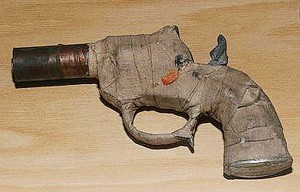
(Connecticut State) An interesting design, this .22 caliber zip gun, built by two high school boys, was seized during an attempt to smuggle it to a relative housed in a CT state prison. It is a cap gun with a pipe barrel, strong rubber band to power the striker and bound with medical tape.
The ingenuity of inmates’ weapons is unparalleled. The late David Marshall Williams, known as “Carbine” Williams, had more than 50 patents for uniquely designed firearms, many of which he created in prison by sketching them freehand on toilet paper.
These guns are usually inaccurate but deadly in close quarters and usually are made for a single shot. As Williams pointed out to me, “Considering most prison shootings are ranged from two to five feet, sights are not real vital.”
While it’s preferable to construct a gun around smuggled ammunition, it is not necessary. Many guns use homemade gunpowder made from match head sulfur, charcoal from burned wood and nitrates from dried urine. Once a fuse made of toilet paper soaked in dissolved match heads is ignited the gunpowder propels a deadly mix of iron, glass and/or nails at the intended target.
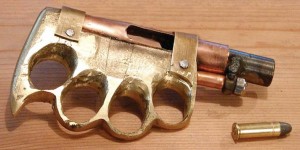
(Snappy Cappy Photos) This zip gun is an unusual design, brass knuckles with a pipe barrel sized for a .38 round.
The targets of gun-wielding inmates can be many and varied. While some guns have been used in the commission of in-house murders and attempted escapes, others have been sold to other cons making the creation of zip guns a lucrative business for entrepreneurial inmates. Over the years, inmates could put a conservative price tag on a prison gun from $300 to $600. Just this past year, an inmate bought two homemade .22-caliber guns, which he attempted to use as part of his escape from a Wisconsin maximum security prison. However, most fabricated guns are used for self-defense, murder or for terrorizing other inmates. Most inmates agree the prison environment is getting tougher, and weapons provide the fear needed to protect their bodies, as well as their property.
“There is a lot of nasty gang shit in here, mostly racial and where you’re from [ethnic],” one career inmate told me. “If you don’t belong to a power group, you’d better be a shadow or a physical power yourself…. It’s a nasty place in here. Some gotta have a weapon just to survive.”
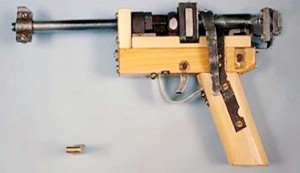
(Snappy Cappy Photos) This zip gun is an unusual design, brass knuckles with a pipe barrel sized for a .38 round.
Even the perceived threat of a weapon can be enough to ward off attacks and threaten inmates and guards alike. Fake “guns” are often produced out of wood and blackened cardboard. Most recently, a Louisiana inmate fashioned a soap gun in order to attempt an escape out of Lafourche Parish Detention Center. John Dillinger was perhaps the most famous inmate to use one “gun” fashioned out of wood and another from soap to escape from an Indiana jail in 1934. This was his second escape; the previous occurring after he smuggled real guns into an Ohio jail.
Although prison guards are trained to look for the markers of illegal weapons, we know that way too many guards are overworked and underpaid. With working for the prison system being one of society’s most stressful jobs, it’s not surprising that weapons are easily manufactured behind prison walls.
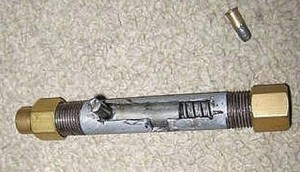
(ATF Photo) This basic zip gun was made from a bolt, nut, and prison shop hardware. It fired a .22 short.
An associate warden in a federal pen said, “We mostly look at behavior. Since any weapons will likely be concealed until the last moment prior to use, we are trained to watch the individual’s behavior. When we do a search, we look for anything that may resemble weapon parts. Being familiar with firearms is really the most helpful thing.”
But, even the use of shake downs does only so much. While they produce large hauls of contraband, which many prisons proudly display for public relations purposes, they do not deter innovative minds from producing more weapons.
“It appears that the frequent use of lockdowns and inspections during and/or following violent events is the only way to reduce prison gun production and violence,” Pennsylvania’s Corrections Secretary John Wetzel, said in 2015.
There is total proof that stricter gun policies and all-out bans will be easily circumvented by homemade weapons. Plus with today’s Internet technology, there are more ways to create effective improvised firearms than at any other time in history. But, even with these new innovations, the human need to protect one’self will supersede all gun control laws, as evidenced by our American prison system alone.
- David Truby bibliography for Prison Guns
Improvised Modified Firearms, Vol. I and Vol. II, by J. David Truby and John Minnery. Paladin Press 1975; 1992.
Zips, Pipes and Pens, by J. David Truby. Paladin Press, 1993; plus other books, research papers, technical data reports, magazine and journal articles and consultant briefings by both the late John Minnery and J. David Truby.



